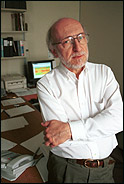Weather watching
 Professor Jacques Derome, the director of the new Climate Variability Network
PHOTO: Owen Egan
Professor Jacques Derome, the director of the new Climate Variability Network
PHOTO: Owen Egan |
|
As the old saying goes, everybody complains about the weather but nobody does anything about it. Thanks to $3 million in funding from different federal government agencies, a new McGill-led research network will at least be in a position to offer some answers about why our weather is the way it is.
The new Climate Variability Network (CLIVAR) was officially unveiled at a press conference last week. The network will be headed by atmospheric and oceanic sciences professor Jacques Derome and will focus on research related to climate change, both naturally occurring and man made.
Derome says that it is crucial for climate change researchers to be able to distinguish the two in the data they collect.
"Whenever we look at global climate change, we're looking at how the temperature and the other variables in the atmosphere are changing over a long period of time. Some people have pointed out that when we observe a change, how do we determine that it's due to greenhouse gases? How do we know that it's not just the result of natural climate fluctuations, which happen all the time?"
Researchers must be able to compare what is within the normal range to what is actually happening. That will be one of the missions of the network.
"We have to gain a better understanding of natural climate variability, how much the climate can change all by itself [without the influence of greenhouse gases]. That strengthens the scientific evidence on the effects of greenhouse gases, because temperature fluctuations cannot then be dismissed as natural occurrences.
"When our negotiators go to sign climate change treaties, they have to be backed up by this hard evidence. There is still a lot of resistance to initiatives to combat greenhouse gases. Many oil companies are still pretending that it is not happening."
Derome, whose expertise is in climate changes from one season to the next, says that the network will look at variability on a number of time scales.
"Once we start studying climate variability, we realize that it changes from year to year, not just over the course of a century. Summers come every year, but why is it that some summers have more droughts than others? We would like to understand how the atmosphere generates this variability, and how much of it we can predict with computer modelling."
In one project launched before the big announcement, Derome and collaborators at other universities are looking at current models, and testing how accurately they can simulate historical weather patterns.
"The Canadian Meteorological Service will be interested in some of our work. We're going to provide some of the science behind their forecasts." Improved weather models may fill a gap; a Gazette article in February reported that accuracy in weather forecasting is going downhill because of budget cuts.
One goal will be to develop a more complete climate modelling system than the ones in use today.
"We want to develop what is known as a 'coupled' atmosphere-ocean model. We will start with an existing model that has a coupling between the atmosphere and the ocean, but we want to adapt it to seasonal forecasting. That means modifying it to reproduce the El Niño phenomenon -- to simulate tropical conditions. It is one of the strongest influences on seasonal conditions."
An El Niño is a warm surface current originating in the Pacific off Ecuador and Peru about once every four to six years. Some of the more severe El Niños have caused droughts, flooding and coastal storms in various parts of the world. Some researchers say it is caused by the greenhouse effect.
Derome feels that pooling expertise in a network will help fill in some of the gaps and approximations which mar some of the accuracy of current computer models.
"Climate change is a phenomenon that plays out on such a vast scale that you need a variety of expertise to work on this problem. You need specialists on seasonal variability, on greenhouse gases and the century time scale. That's why we need a network."
In all, three new research networks in the field of environmental studies have been created with funding from the Natural Sciences and Engineering Research Council and other sources. The other networks will be the Collaborative Mercury Research Network (COMERN) and the Biocontrol Network.
Some of the McGill researchers who will be involved in CLIVAR projects include Derome's departmental colleagues Lawrence Mysak and David Straub, and adjunct atmospheric and oceanic sciences professor Gilbert Brunet.
NSERC will provide the bulk of the funding for CLIVAR with support also coming from the Canadian Foundation for Climate and Atmospheric Sciences and the Meteorological Service.
COMERN, based at the Université du Québec à Montréal, will do research on the presence of mercury in ecosystems and the risks it poses to those who eat fish. McGill researchers involved in COMERN include atmospheric and oceanic sciences and chemistry professor Parisa Ariya, geography professor Gail Chmura, Professor Laurie Chan from the Centre for Indigenous Peoples' Nutrition and Environment and earth and planetary sciences professor Alfonso Mucci. COMERN has $12.6 million in funding from NSERC.
McGill will also be involved in the Biocontrol Network which has $6.6 million in NSERC funding. It is headquartered at Université de Montréal.

